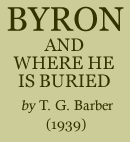< Previous | Contents | Next >
CHAPTER 18.
THE VALLEY OF DECISION.
1822—1823.
The voyage to Genoa was without incident. Mary Shelley had made all the necessary arrangements for the accommodation of the party upon arrival. For herself and the Hunts she had secured a large house on a hill, from which there was a beautiful and extensive view of the sea. At no great distance from this, in the same quarter of the town, she found a moderate-sized villa for Byron and the Gambas, called the Casa Saluzzo.
When they had settled in, the Hunts proved to be a continual source of annoyance to Byron. They could not dismiss from their minds the idea that he was responsible for the failure of The Liberal, and they went out of their way to show their resentment. Relations between the parties became more and more strained—visits to one another’s houses less and less frequent—until at last all direct communication between them was broken off, and Byron arranged through the agency of his steward to make the Hunts a weekly allowance.
Byron did not take kindly to the situation, and once more he began to think seriously of leaving Italy altogether. Moreover, life at the Casa Saluzzo was not all that he could desire—it was monotonous and uneventful.
True, he had Teresa and the Gambas with him, but their society was beginning to lose its charm. He was still fond of Teresa, but for four years he had moved about from place to place at her bidding, and he was becoming weary of this enforced pilgrimage. There came over him again the feeling that he had wasted, and was wasting, his life. He could not retrace his steps, but he could go forward. Whither? Was it to be England? Could he return thither, and start life all over again? How often during his long exile had he longed for home! He had not forgotten; the memories of his early haunts were still with him. London? No, not London. Newstead? Annesley—the long terrace with its festooned wall—the bridle path winding round the hill with its “peculiar diadem” of trees? “I often look back on the days of my childhood and am astonished at the recollection, of the intensity of my feelings at that period; first impressions are indelible. . . . . I remember my youth when my heart overflowed with affection ...”
It was only a memory, from which at one time he had tried to escape—the memory of what might have been—the memory of a disappointment—it had been agonising once, but now—this was not the memory from which he desired to escape, it was painful still, but there was no shame attached to it. From other memories he sought relief, memories of the intervening years. On the eve of his thirty-third birthday he had written: “I go to bed with a heaviness of heart at having lived to so little purpose. My regret is not so much for what I have done, as for what I might have done.”
These were the memories from which he was now trying to escape—memories of lost opportunity and irresolute purpose. But his spirit was moving within him —there was still time for action.
The idea that he was destined for some active calling was asserting itself with a firmer hold. Action! where, and how, was he to act?
It was at this time, whilst his mind was being exercised by these things, that Lady Blessington crossed his path. He had a slight acquaintance with her husband before their marriage, but he had never seen her. She, with Lord Blessington and Count Alfred d’Orsay, a Frenchman, and a friend of the family, arrived at Genoa on the last day of February, 1823, and on the next day she and Byron met.
She had been looking forward to this meeting. “I never before felt the same impatient longing to see anyone known to me only by his own works,” she wrote in her diary. The impression of the first few moments disappointed her, as she had, from portraits and descriptions given, quite a different idea of him, but in a very short time she succumbed to his charms. “His appearance is highly prepossessing. His head is finely shaped, and his forehead open, high, and noble; his eyes are grey and full of expression, but one is visibly larger than the other. The nose is large and well-shaped, but, from being a little too thick, it looks better in profile than in front-face; his mouth is the most remarkable feature in his face, the upper lip of Grecian shortness, and the comers descending; the lips full and finely cut. . . . His chin is large and well-shaped, and finishes well the oval of his face. . . . His countenance is full of expression, and changes with the subject of conversation; it gains on the beholder the more it is seen, and leaves an agreeable impression .... he is very slightly lame, and the deformity of his foot is so little remarkable, that I am not now aware which foot it is.”
This description of him is found in Lady Blessington’s Journal of Conversations with him, which she published ten years after his death.
Byron and she were together two months, and the friendship which developed between them during that time, was exceptionally happy. Lady Blessington was charmingly natural, clever, refined, tactful, and generous.
She brought out the best in Byron, and probably helped him more than any other woman he had ever met. Byron gave her his confidence, and there is no doubt that he discussed with her those things which of late had been exercising his mind. What was he to do? How could he make the best of his life? She must have helped him to decide, for when she left Genoa on June 3, 1823, he had made up his mind to go to Greece.
